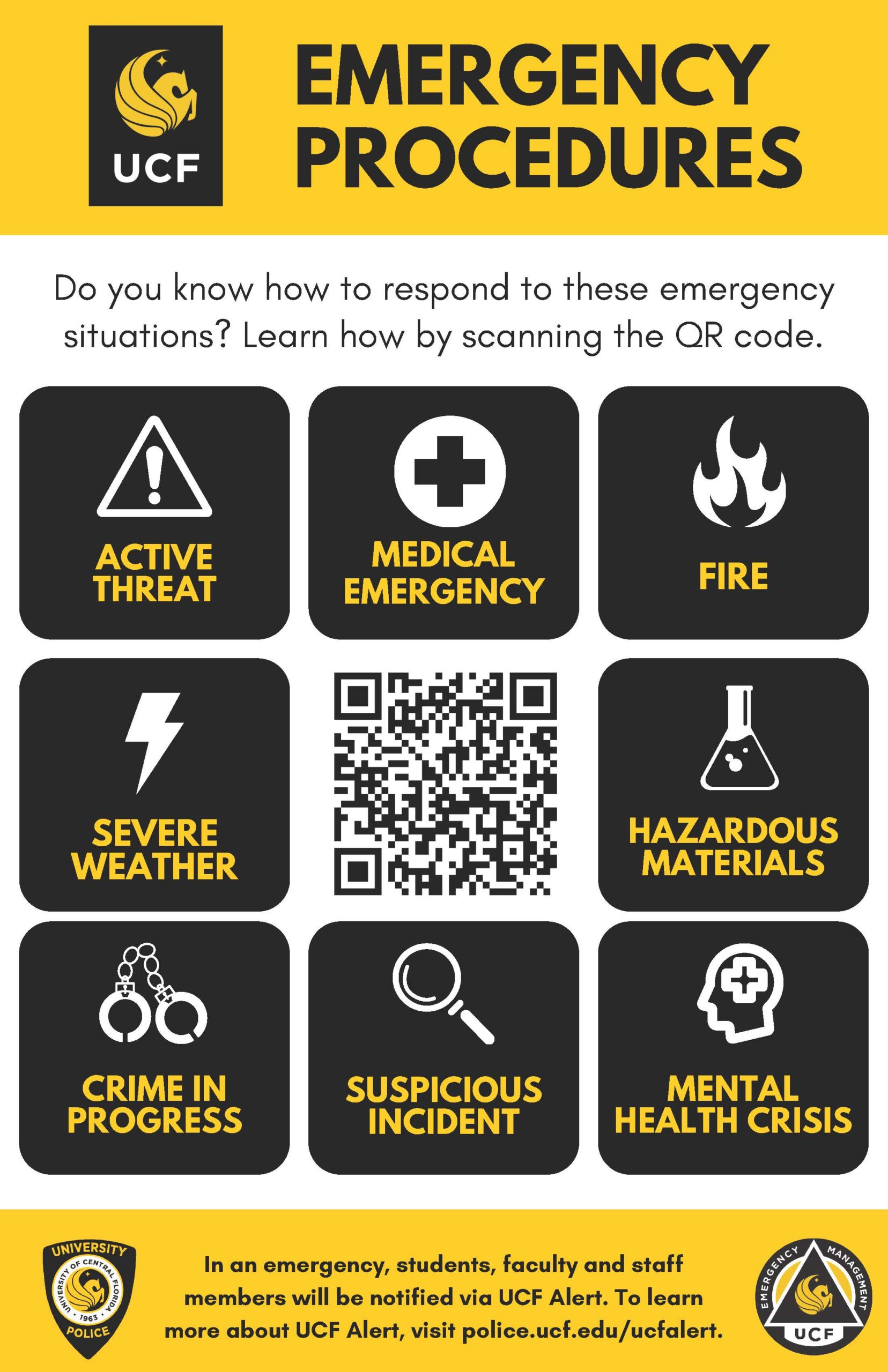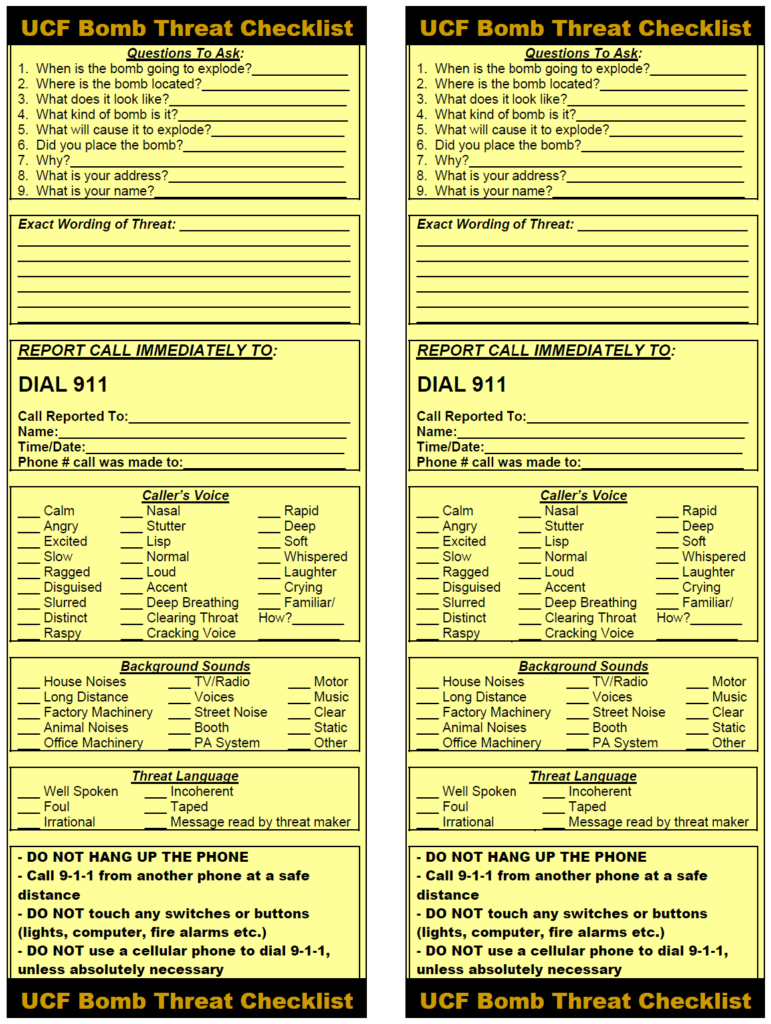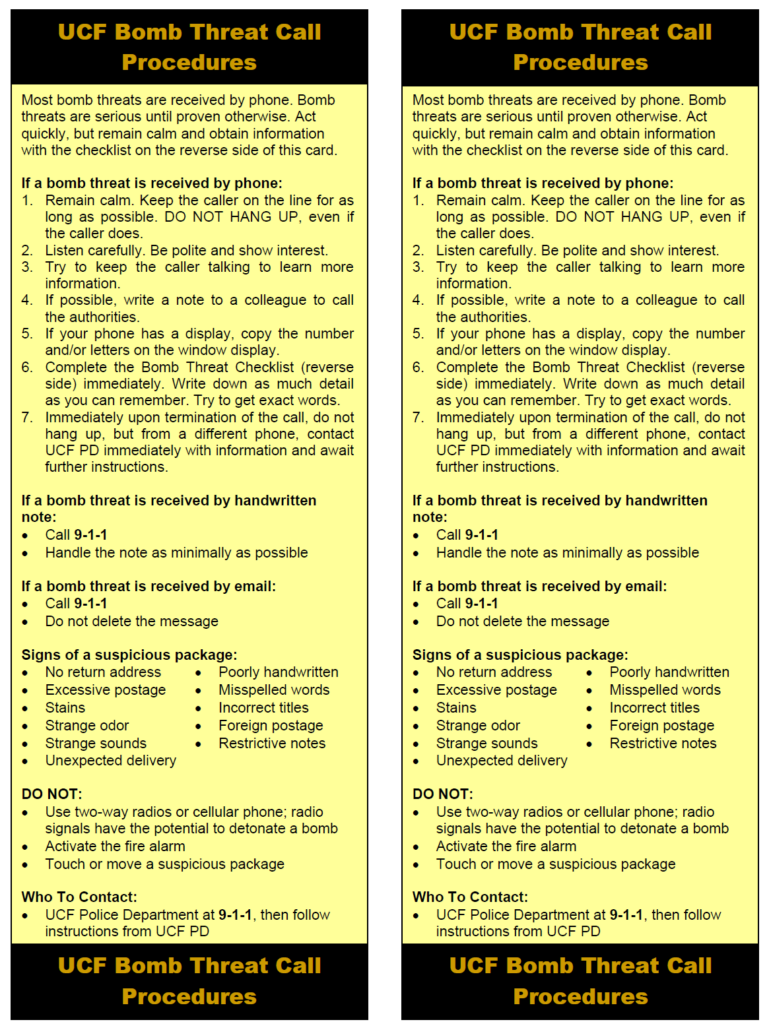Emergency Procedures
Emergencies on campus are rare, but if one should arise, it’s important to be familiar with some basic safety and security concepts.
Every UCF classroom contains an emergency procedure guide posted on a wall near the door. You should make a note of the guide’s physical location and review the online version below.
In an emergency, always dial 911.

Emergency Guides
Emergency Reporting and University Contacts
An emergency is any situation that requires an immediate police, fire, or medical response to preserve life or property. In an emergency, always dial 911.
UCF Alert
UCF Alert is a multi-media communications system that provides timely and accurate information about emergency situations that could impact the university. It features several communications tools, including e-mails, text messages, web updates, social media, and indoor and outdoor sirens.
It’s important to keep your UCF Alert contact information up-to-date so you’re notified in an emergency. To update your information:
- Go to www.getrave.com/login/ucf
- Log in using your NID and password. If logging in for the first time, you may be prompted to type “University of Central Florida” in the site name field
- On the “My Account” tab, verify the information including your e-mail address and mobile phone number
- Your UCF email address is listed by default; to add an additional email address, click the “Add” button
To edit your mobile phone number, click the “Edit” icon and follow all prompts for mobile phone verification
Lockdown
A lockdown is when classrooms, offices, and other enclosed spaces are used as a physical barrier to protect people from an immediate threat. During a lockdown, doors can be locked using either electronic access or manual means. Once in lockdown, electronic card access may be impacted, preventing entry to electronically-controlled spaces. The community will be notified of a lockdown situation via UCF Alert.
In the event of a lockdown:
- Avoid halls and public spaces
- Shut and lock classroom and/or office doors and windows
- Turn off classroom and/or office lights, computer monitors and close blinds, if possible
- Move room occupants out of line of sight from windows and doors
- Remain calm and quiet
- Silence cell phones (but do not turn them off)
- Be aware of alternate exits if it becomes necessary to flee
- DO NOT:
- DO NOT attempt to lock the building’s outside access points
- DO NOT prop open doors
- DO NOT grant entry to the space or respond to anyone at the door until an “all clear” is received via UCF Alert or authorized by UCF Police
Evacuate
An evacuation is the dispersal of people from a dangerous or potentially dangerous area. Properly preparing for an evacuation includes identifying and designating evacuation points and a primary and alternate location to reunite. Each department should designate a coordinator to account for all persons upon reunification.
- Cease all activities and leave building or area immediately
- Shut off laboratory equipment and other hazardous processes
- Follow exit signs to the nearest safe exit and notify others on your way out
- Help those who require assistance to evacuate safely
- Ensure visitors follow evacuation procedures
- Move away from the building (at least 200 ft) and proceed to designated evacuation assembly area
- Notify UCF Police or fire department personnel if anyone is waiting for assistance or missing from the evacuated building or area
- DO NOT:
- DO NOT re-enter the building or area until an “all clear” is received via UCF Alert or authorized by UCF Police or fire department personnel
- DO NOT use the elevators unless authorized by UCF Police or fire department personnel
- If you are required to evacuate the building or area but are unable to do so:
- Go to the nearest area where there are no hazards, such as a stairwell
- Call 911 and inform them of your specific location
- Remain calm, emergency personnel will arrive
Shelter-In-Place
Shelter-in-place is the process utilizing a physical structure or building to temporarily shelter individuals from a hazardous outdoor environment. Some examples are wildfires, hazardous weather, utility emergencies, chemical or biological threats, radiological releases or explosives.
Hazardous Weather Shelter-In-Place Protocol:
- Under severe weather watch conditions, suspend any outdoor activities and designate an individual to monitor weather conditions for potential warning conditions
- Under severe weather warning conditions, move to appropriate shelter-in-place location(s)
- Take shelter in first floor hallways, interior classrooms, and interior offices
- Move away from outside windows and doors, and avoid objects that could become projectiles
- Assume kneeling position with head between the knees and hands/arms covering head
- Avoid sheltering underneath heavier objects that may fall
- Report injured or trapped individuals to first responders
Outdoor Hazardous Material/Utilities Shelter-In-Place Protocol:
- Move to appropriate shelter-in-place locations
- Close all windows and air conditioning vents and, if possible, turn off/disable heating and cooling units
- Do not turn on any lights or electrical equipment
- Seal windows and doors to restrict the entry of any contaminated outside air
- Report injured or trapped individuals to first responders
- Once shelter-in-place is activated, remain in that condition until an “all clear” is issued
Active Threat
Active threat situations involve the use of firearms or other weapons to target as many victims are possible, with no pattern or method to the selection of victims. These situations are unpredictable and evolve very quickly. Each active threat scenario is different, and it’s up to the individual to determine their best option based on their specific situation.
In the event of an active threat, choose the best course of action and act immediately.
- AVOID. Pay attention to your surroundings and have an exit plan. Get as much distance and as many barriers between you and the threat as quickly as possible.
- DENY. When avoiding is difficult or impossible, deny the threat access to you and your space. Lockdown by creating barriers, turning the lights off and remaining quiet and out of sight. Make sure your cell phone is silenced, but do not turn it off.
- DEFEND. When you are unable to put distance between yourself and the threat, be prepared to protect yourself. Commit to your actions, be aggressive and do not fight fairly. Do whatever it takes to survive.
When Law Enforcement Arrives:
- Law enforcement is trained to eliminate the threat as quickly as possible
- DO NOT run at the responding officers or attempt to hold on to them for safety
- Follow all instructions provided by law enforcement
- Avoid quick movements and keep hands visible at all times
Medical Emergency
If you have an injury or illness requiring immediate care:
- Dial 911 and follow instructions given by the dispatcher
- Have properly trained individuals administer first aid or CPR, if needed
- Assign an individual to meet and guide the emergency medical responders to the individual
- If needed, locate the nearest Automated External Defibrillator
- DO NOT:
- DO NOT move the injured/sick person unless necessary for immediate safety
- DO NOT approach victims of electrocution or toxic exposure unless they are cleared from the hazard
- DO NOT contact Student Health Services for a life-threatening emergency
Fire
Prior to an emergency, familiarize yourself with exits and fire safety equipment, and designate an assembly area for evacuations.
R.A.C.E Fire Response Procedure
Rescue/Remove
- Rescue or remove any persons in immediate danger
- Assist individuals with disabilities
Alert/Alarm
- Activate the nearest fire alarm
- Alert emergency personnel by dialing 911
Contain
- Contain the fire by closing all doors, where possible
- Turn off electric and gas equipment in your area as you evacuate, if possible
Evacuate/Extinguish
- Evacuate the building through the nearest stair exit
- Stay low and crawl to nearest exit if smoke is present
- Extinguish a small fire using a fire extinguisher, if possible
If smoke, heat, or flames block your exit routes:
- Dial 911 and report your location
- Close as many doors as possible between you and the fire
- Place wet cloth material around or under the door to prevent smoke from entering the room
To use a fire extinguisher, remember PASS.
- Pull safety pin from handle
- Aim at base of fire
- Squeeze the trigger handle
- Sweep from side to side at base of fire
Mental Health Emergency
A mental health crisis is a potentially life-threatening situation in which an individual is imminently threatening harm to themselves or others. The person may also be disoriented, have a severe inability to function, and be distraught and out of control. If you are aware of a student experiencing challenges or difficulties, report the concern using the university’s Person of Concern form. Every submitted form is reviewed by UCFPD’s Threat Management Team, who follows up to ensure the individual is safe and has the resources they need, like UCF’s Counseling and Psychological Services or Student Care Services.
In an emergency, always dial 911.
Take all threats seriously!
- Monitor the person making the threats from a safe distance
- Dial 911
- Provide as much identifying information as possible to the dispatchers
- Stay in a safe area until emergency personnel arrives
DO NOT:
- DO NOT physically confront the person
- DO NOT block the person’s access to an exit
If you or someone you know is experiencing mental distress, know that you are not alone and UCF has resources available for you.
- Emergencies: 911
- Suicide prevention hotline: 988
- Counseling and Psychological Services (CAPS) Crisis Line at 407-823-2811 (press 5)
- Employee Assistance Program: 877-240-6863
Hazardous materials
Minor spills of hazardous materials that pose little or no threat to the safety and health of personnel can be cleaned by trained personnel. A hazardous material emergency exists when clean-up of hazardous material is beyond the level of knowledge, training or ability of the staff in the immediate area or if the spill creates a situation that is immediately dangerous to the life and health of those in the facility or surrounding area.
Indoor/laboratory hazardous material emergency
- Dial 911 and provide as much information as possible to the dispatcher
- Implement the evacuation procedure and exit to designated outdoor assembly area
- If the hazard affects the entire building, evacuate the building using the fire alarm
- Turn off adjacent burners or heating equipment to minimize risk of fire
- Close doors and windows as you leave the room to confine the hazard
- Stay in a safe area until emergency personnel arrive and give direction
Outdoor hazardous material emergency
- Dial 911 and provide as much information as possible to the dispatcher
- Implement the shelter-in-place procedure; take shelter indoors and away from the hazard
- Seal rooms and offices
- Understand that it may become necessary for university personnel to shut down the HVAC system to prevent fumes or smoke from entering the building
- Remain inside until “all clear” is issued by emergency personnel
Gas Leaks and/or unknown odors should be reported to UCF Police by calling 911.
Hazardous weather
Weather conditions in Central Florida can change quickly and unexpectedly. Always monitor the weather and take precautions to minimize the potential of being affected by threats associated with hazardous weather.
Severe thunderstorms, lightning, and tornadoes:
- Implement the shelter-in-place procedure; take shelter indoors and away from the hazard
- Move to the lowest floor in the middle of the building, and stay away from doors and windows
- Avoid seeking shelter under trees or tents, as they may not provide adequate protections
- Stay inside until dangerous weather has passed
- Dial 911 and follow the medical emergency procedure if anyone is struck by lightning or becomes injured while seeking shelter,
Flooding
- Implement the shelter-in-place procedure; take shelter indoors and away from the hazard
- Get to higher ground
- Avoid flood waters and never drive or walk through flood waters
- Protect area with sandbags, barriers, or other absorbent materials, if possible
- Dial 911 if anyone is trapped in flood waters or becomes injured while seeking shelter
Suspicious Person/Vehicle/Object
Suspicious can be defined as anything that appears unusual or out-of-place. If you witness a person, vehicle, or object that makes you feel uneasy, trust your instincts and report it. If you see something, say something – immediately and to police – and UCFPD will do something.
Suspicious person or vehicle
- Dial 911 and provide as much information as possible to the dispatcher
- Keep a safe distance and remain where you are until a police officer arrives
- Consider implementing the lockdown or active threat procedure, if the suspicious person or vehicle becomes hostile or appears threatening.
Suspicious object
- Dial 911 and provide as much information as possible to the dispatcher
- Move yourself and others away from the object; 300 feet is recommended
- DO NOT:
- DO NOT move or open the object
- DO NOT investigate too closely
- DO NOT cover or insulate the object
Bomb Threat
A bomb threat involves threatening to detonate an explosive device with the intent to cause injury, death, or property damage, whether or not a device actually exists. Bomb threats may be communicated verbally or non-verbally, and indicate that a bomb has been or will be placed somewhere to cause harm.
We recommend keeping the bomb threat checklist below readily accessible for quick reference during an emergency.
If you receive a bomb threat by phone:
- Dial 911 as soon as possible
- Write down the caller’s exact words
- Note the time of the call
- Gather as much information as possible from the caller
- Decide to lock down, shelter-in-place, or evacuate based on the threat description
If you receive a written bomb threat:
- Dial 911 and provide as much information as possible to the dispatcher
- Visually scan classrooms, hallways, bathrooms, and evacuation locations for suspicious objects or devices
- Decide to lock down, shelter-in-place, or evacuate based on the threat description
Additional resources:

